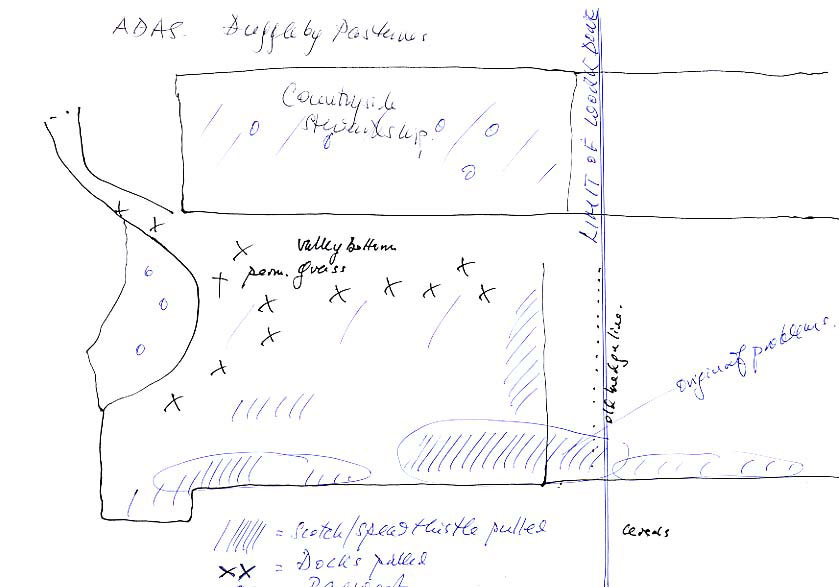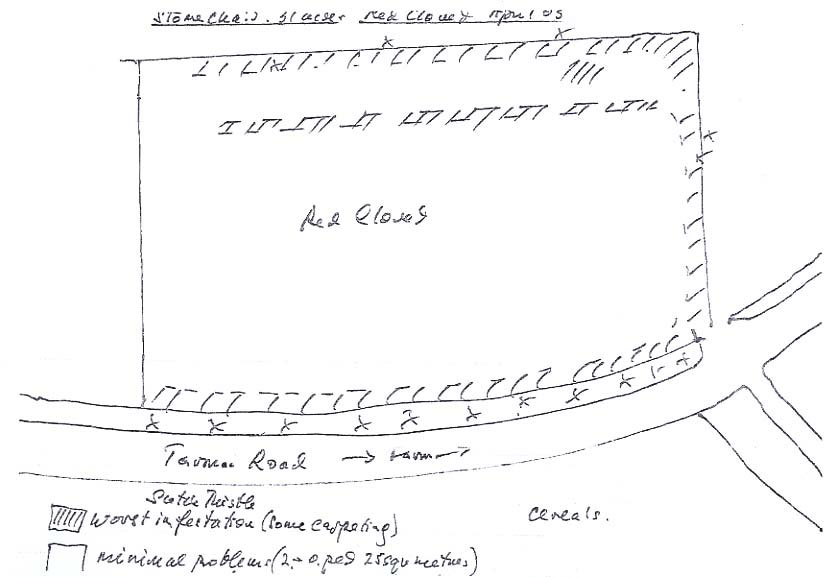Report T018 *****
Problem:
Spear thistle & Dock in Red Clover (grown for seed).
Ragwort, Spear Thistle & Docks, in permanent pasture
Where: ADAS High Mowthorpe, North Yorkshire
When: April 2003
Status: Organic
Area: 12.55 Hectares Seeds / 16.19 Hectares PP. (31 Acres
/ 40 acres)
Detail: 4 / 5 man workforce
click map for larger version
click map for larger version
ADAS, High Mowthorpe. April, 24th, 25th 26th. 2003.
a) Docks and Spear thistle in Red Clover seed crop.
b) Docks in permanent pasture. Organic & Countryside Stewardship.
Crop: Red Clover grown for harvesting as seed and silage (Sown Spring 2002)
Problem: Mainly Spear Thistle, but also Docks, Sow & Creeping Thistle.
Area: 31 Acres / 12.5 Hectares (Stone-chair field, see drawing).
Conditions: Wold land, shallow, dry, stony on brows. Deeper in dip valleys and flats.
Management: After a Spring 2002 sowing, the crop had been Autumn grazed by set-stocked cattle. This had opened up the ground along the fence-lines (esp. the roadside). The weed problems were also increased by feed vehicle tracks, seed take-up failure on stony areas, and two field-length drill breadths (where the seed ran out).
Density of weeds : Variable, from low in well established clover crop (0 to 2 per 25 sq. metres), to very high in the unsown & exposed areas (up to 50 or more per 25 sq. metres).
Causes: Docks were mostly found alongside the boundary, seeded by established plants in the roadside verge or fence lines. Scotch thistle probably came from the seed-bank (along with Sow thistle). Creeping thistle was found in one damp field corner, growing from the established rhizome, broken into new sections by cultivations. The worst problems were related to small areas of crop failure or the cattle grazing along the boundary fences.
Clearing the weeds:
Day 1. It took five men 7 hrs to remove the new docks & scotch thistle from a 5 metre strip that ran alongside the road (stony & thin). On the other hand, it took one man only 1.5 hours to remove old docks in the roadside verge, which were the source of that problem. (Day total = 37 man-hours)
Day 2. Five men walked 90 % of the field and removed Scotch thistle rosettes & about 50 dock plants. It rained (1st for two months) in the afternoon. Approx. 30% of the worst weed Spear thistle infestation in exposed breadths (to the West), was tackled. 35 man hrs were spent removing rosettes that covered the ground.
Day 3. Four men took five hours to clear one and half field-length drill bredes, carpeted with Scotch thistle, with a few docks along the Western fence line. They also picked up the dock piles from earlier work & put them in a pile for collection. They chisel-hoed a small but intense bed of creeping thistle near the entrance (10 minutes). (Day total = 20 man hours)
Costs:
Wages @ £7.14p per hour of lifting: £656.
Travel & materials cost. Travel & tools: £.70.
Total: £850. (or £27 per acre ).
Assessment: an estimated 70% of weeding costs would have been avoided by crop cover. During sowing, the seed drill seemed to have run empty for two field length breadths, and there was no evidence of follow-up repairs on the stony ground. (This was not noticed during an inspection of the field with Derek Knight).Cattle were set-stocked rather than strip grazed. There were vehicle tracks through the crop (for feed delivery ?), and the fence-line docks had not been left to mature. Too much time was spent weeding in areas where the crop had failed, and the dry /stony conditions made this work very difficult. Some of this work could have been tackled in Autumn.2002.
More work at A.D.A.S. High Mowthorpe. 29th & 30th April 2003
Permanent grassland in valley bottom & fenced countryside stewardship banks. (Organic)
Problems: a) Docks in valley bottom (clustered), b) Scotch / Spear thistle across whole site especially on the tops of western banksides. c) Ragwort in fenced countryside stewardship.
Area: Approx. 25 acres.
Conditions: Moist.
Management : Controlled & light grazing from 25 head of cows (+ their followers ?)
Clearing the weeds (see drawing)
Day 1. Three men pulled docks & Spear thistle in valley bottom. Ragwort & thistle were pulled from the fenced countryside-stewardship bank area (to the East). (21 man-hrs)
Day 2. Divided .
Task A : Three men pulled remaining docks, spear thistle & ragwort from all over site. Spear thistle was worst (& distributed from), the top of the Western banksides. (15 man hrs) Cost to walk & clear this field area was £12 per acre.
Task B: Two men did a trial hour in the white clover pastures alongside the road, pulling young docks & spear thistle (2 man hours). It would take two men a day to clear this field.
Task C: One man loaded dock piles into the trailer (1 man hour).
Task D: Three men cleared Scotch thistle & Docks from the fence line (between fields of organic wheat & peas.) Both were left on the ground, docks piled for later collection. (3 man hours).
Costs: 42 man hours @ £7.14 = £.299.
Expenses £25.
Total: £324.88p
Assessment: the mostly deep & moist soil made for reasonably easy use of the Lazy Dog. A ‘control area to the South of field ‘1’ will show up the work, which needs follow-up (plants are missed in rough conditions). The follow-up work on this site should now only be 3 or 4 man hours annually. The work on the dividing fence was really important, because it dealt with the source of long term trouble. The trial hour in the white clover ley suggested that this would cost no more than £149 to clear.
Important: It is inevitable that a rosettes & plants will have been missed (despite thousands cleared). It is essential to follow up this work by inspecting the fields at a later stage in the growing season, and by removing plants before they set seed. Estimate 5 man hours.
[ this report was written by P.Trevelyan 29th April 2003].
